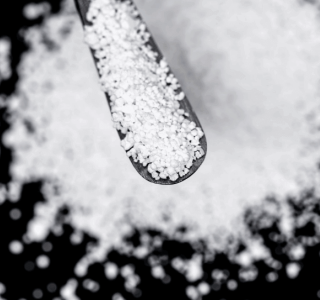Nobel Biocare partnered with Mimetis Biomaterials S.L. and launches creos™ syntogain, biomimetic bone graft substitute.
creos™ syntogain joins creos™ syntoprotect, creos™ xenoprotect, creos™ xenogain and creos™ mucogain to establish Nobel Biocare as the supplier of choice for organic or synthetic regeneration need.
Nobel Biocare is launching creos™ syntogain, expanding its portfolio of regenerative solutions distributed under the creos™ brand.
creos™ syntogain, already known and appreciated in the Spanish market since 2016 as MimetikOss, is a biomimetic bone graft substitute designed for efficient regeneration.1
creos™ syntogain, is the latest generation of synthetic bone grafts1 developed by Mimetis Biomaterials S.L., a biomedical spin-off from the Biomaterials, Biomechanics and Tissue Engineering (BBT) group of the Polytechnic University of Catalonia (UPC) with whom Nobel Biocare partnered as early as 2016.
“For many reasons synthetic bone grafts represent an increasingly popular alternative to animal-derived materials and patients are directly asking for it. With this product launch we enable dental professionals to meet their patient's wishes with a safe and efficient product” said Tinne Van Delm, Director of Product Management and Marketing - Regenerative Solutions. “The partnership with Mimetis is in line with Nobel Biocare and Envista's strategy to focus on the fastest-growing segments of the dental market and create differentiated solutions to improve patient care. With Mimetis we added a unique set of talented biomedical engineers and scientists to our team, making up a proactive, highly dedicated team fully focused on the latest technology progress in synthetic bone regeneration”.
The manufacturing process of creos™ syntogain in an aqueous environment and at low temperature enables to get a bone graft with four differentiators:
– The unique composition of the material1,2,3 made of 80 % of Calcium Deficient Hydroxyapatite (CDHA) and 20% of β-TCP(beta-tricalcium phosphate) mimics human bone that is also made of CDHA1,2,3: the closer a material resembles human bone, the better it is for bone formation.4
– The microscopic surface of the material, being made of nanocrystals1,7 leads to a high specific surface area1,8,9 that helps the cells to attach for the bone generation.10
– The high nano-/microporosity1,11 similar to the natural bone’s structure allows good inflow of blood, cell colonization and reliable bone formation.11
– The round shape of the granules1,5 makes creos™ syntogain easy to apply in situ6, avoiding the typical stacking effect of the flake-shaped granules.
“The result is a bone that is stable1 and that maintains the volume of the defect starting from day one1,5 with predictability on the clinical outcome as shown in a clinical case series12 collected in the last 9 years.” said Julien Tromenschlager, Senior Product Manager Regenerative Solutions. “Thanks to its composition, bone ingrowth between and within the granules (due to osteoconductive properties) allows to maintain a stable volume in the regenerated defect.”1,5
In addition, in one of the largest randomized control clinical trial performed in dental bone regeneration, creos™ syntogain showed non-inferiority with the reference deproteinized bovine bone matrix (DBBM) in terms of dimensional variation of the alveolar ridge (vertical and horizontal change % at 6 months post bone grafting) and insertion torque and Implant Stability Quotient (ISQ).13
The product, manufactured in Spain under strict quality standards, is available in selected EU countries in two granule sizes (0.2-1.0 and 1.0-2.0 mm) and two different volumes (0.5, 1.0 cc). A 2.0 cc version will be launched later.
creos™ portfolio also includes creos™ syntoprotect, dense PTFE membrane, creos™ xenoprotect, a natural membrane with outstanding handling that facilitates bone gain, creos™ xenogain, bovine bone for successful regeneration and creos™ mucogain matrix for soft tissue regeneration.
For more information on creos™ and the new creos™ syntogain, you can visit nobelbiocare.com/creos or contact a local Sales Representative.
Discover more: click here
References
1. Hoornaert A, Maazouz Y, Pastorino D, Aparicio C, de Pinieux G, Fellah BH, Ginebra MP, Layrolle P. Vertical Bone Regeneration with Synthetic Biomimetic Calcium Phosphate onto the Calvaria of Rats. Tissue Eng Part C Methods. 2019 Jan;25(1):1-11. doi: 10.1089/ten.TEC.2018.0260. PMID: 30501579. Read on PubMed.
2. Barba A, Diez-Escudero A, Espanol M, et al. Impact of biomimicry in the design of osteoinductive bone substitutes: nanoscale matters. ACS Appl. Mater. Interfaces 2019. DOI:10.1021/acsami.8b20749.
3. Data on file: Mimetis XRD analysis report using the RIR quantification method. Medical device composition certificate.
4. Rufino Senra M, de Fátima Vieira Marques M. Synthetic Polymeric Materials for Bone Replacement. J. Compos. Sci. 2020,4, 191; doi:10.3390/jcs4040191. Read on MDPI.
5. Raymond Y, Pastorino D, Ginebreda I, et al. Computed tomography and histological evaluation of xenogenic and biomimetic bone grafts in three-wall alveolar defects in minipigs. Clin Oral Investig. 2021 Dec;25(12):6695-6706. doi: 10.1007/s00784-021-03956-y. Epub 2021 May 1. PMID: 33931811. Read on PubMed.
6. Data on file: Granules handling Voice of Customer from 2017-2018 + GKEM Handling Questionnaires Results from 2022.
7. Barba A, Diez-Escudero A, Maazouz Y, et al. Osteoinduction by foamed and 3D-printed calcium phosphate scaffolds: effect of nanostructure and pore architecture. ACS Appl. Mater. Interfaces 2017.DOI:10.1021/acsami.7b14175.
8. Sadowska JM, Guillem-Marti J, Montufar EB, Montserrat E, Ginebra MB, Biomimetic versus Sintered Calcium Phosphates: The in vitro Behavior of Osteoblasts and Mesenchymal Stem Cells. Tissue Eng Part A. 2017 Dec;23(23-24):1297-1309. doi: 10.1089/ten.TEA.2016.0406. Epub 2017 Feb 21.
9. Data on file: Milestone 2 study (page 18).
10. Konka J, Espanol M, Bosch BM, de Oliveira E, Ginebra MP. Maturation of biomimetic hydroxyapatite in physiological fluids: a physicochemical and proteomic study. Mater Today Bio. 2021 Sep 15;12:100137. doi: 10.1016/j.mtbio.2021.100137. PMID: 34632362; PMCID: PMC8487082. Read on PubMed.
11. Ginebra MP, Espanol M, Maazouz Y, Bergez V, Pastorino D. Bioceramics and bone healing. EFORT Open Rev 2018;3 DOI: 10.1302/2058-5241.3.170056. Read on PubMed Central.
12. Data on file: Clinical cases from 2022.
13. Ginebra Cairó I., Roig Cayón M., Velasco-Ortega E. et al., Biomimetic synthetic bone graft in alveolar ridge preservation: 1-year RCT results, Abstract N°EAO-647 EAO Geneva 2022.


